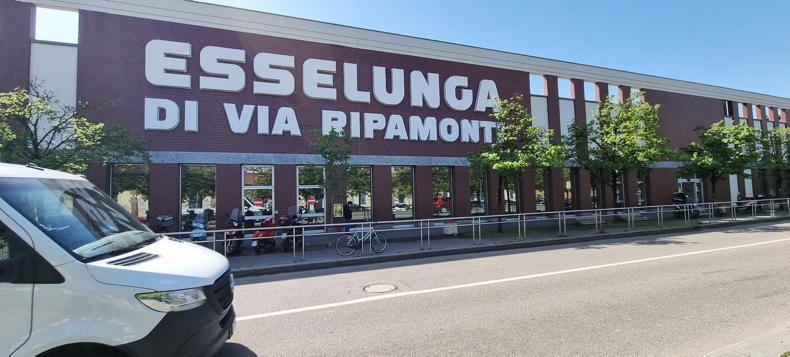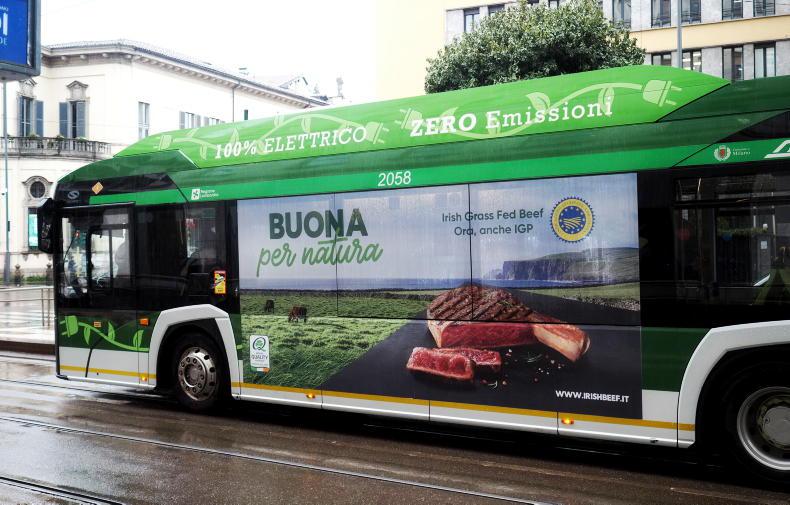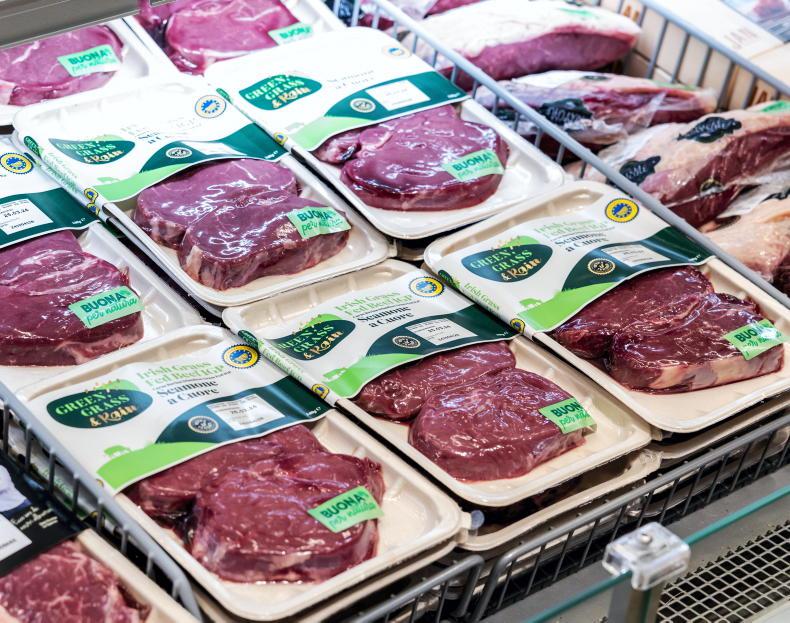The long-awaited PGI for Irish Grass Fed beef was secured at the end of last year when the EU announced that the Irish application was successful.
While that was a challenging process, an even more difficult one to turn this approval into something worthwhile in the marketplace has just begun.
The start of this new journey commenced in Esselunga stores in Italy around the St Patrick’s festivities in March and the Irish Farmers Journal has now travelled to see how this branded Irish beef product looks on the supermarket shelf and what type of competition it faces.
Italy ideal target market
Bord Bia advised that based on its market research, the Italian market was ideal for the launch a PGI product.
James O’Donnell, who heads Bord Bia’s Milan office, told the Irish Farmers Journal that PGI branding resonates with Italian consumers.
He said that even those who aren’t familiar with the finer points recognise that a PGI label attached to a product is a “good thing.”
As Figure 1 shows, Italy, France and Spain are foremost among EU countries for PGI brand recognition.
The current PGI grass-fed beef offering on the shelves of supermarket Esselunga is just one cut, the rump heart which sells just below striploins and fillets at the premium end of the beef market.
The current range of Irish beef on sale in Esselunga extends to nine pre-packed cuts and the ambition is that the PGI will extend to all of these in due course.
In terms of positioning in the Esselunga beef offering, O’Donnell said that “Irish beef already enjoys an excellent reputation for quality and it is the ambition for Irish beef in Italy that it is a premium product but sufficiently affordable to secure volume sales”.

Esselunga supermarket, Milan.
It was clear that a US striploin steak meat cut was available at a higher price than its Irish counterpart but that means a low volume of product sales.
As for how Irish Grass Fed PGI beef will function alongside the non-PGI offering, O’Donnell explained that “securing a PGI added an extra tier of quality to an already highly regarded product”.
He said that “the Italian market, while placing a high value on domestic production as all countries do, was particularly receptive to a high-quality imported product as well”.
This is because Italy produces just 47% of the beef that it consumes, which creates an open door for external suppliers without displacing domestic product.

PGI Irish Grass Fed beef promotion campaign.
As well as a supply deficit, the Italian market is an excellent fit for Irish beef exports because of the extent to which Italian consumers value food.
O’Donnell said that “food is a centre point of Italian life and meals are an occasion and an event” as opposed to simply refuelling.
Less dining on the move
There is much less dining on the move than in Ireland or many other markets.
The top three considerations for Italian consumers when buying beef are taste, tenderness and animal welfare, and Irish beef scores consistently well on all three. Having a PGI attached will enhance further the high reputation Irish beef has in the Italian market.
The Italian food retail market is much more fragmented than is the case in Ireland or the UK.
There remains a strong core of independent food retailers in the Italian market and independent butchers retain 30% of all beef sales with 70% through supermarket outlets.
Esselunga, for example, has 170 stores, mainly in northern Italy and a €9bn turnover. It has around 9% of retail beef sales and Irish beef sells alongside other European offerings and a small selection from Australia, the US and Argentina.
The vibrant independent retail sector is also a significant outlet for Irish beef in Italy.

Irish PGI Grass Fed beef on sale in Italy.
Giorgio Pellegrini, who is the president of the Milanese Butchers’ Association, leads a premium retail outlet that has extended into a parallel high-end dining business, targeted at consumers in Milan’s city centre.
This may provide a similar function to what is provided on a grab-and-go basis by most Irish convenience stores for breakfasts and lunches, but as is Italian custom, it is a proper knife-and-fork meal as opposed to a carryout.
Giorgio is a Bord Bia ambassador for Irish beef in Italy and, unsurprisingly, is a strong knowledgeable advocate for the product.
What was somewhat surprising was that he was prepared to rank it ahead of Italian for consistent quality, and the Irish beef production process in harmony with nature is central to his marketing strategy.
He has an international outlook when sourcing and identifies Spain and Poland as the main competitors for Irish beef in Italy.
Irish Grass Fed beef on sale in Esselunga supermarkets.Italy is 47% self-sufficient for beef and it imports the rest.Independent butchers have a 30% share of beef market.PGI creates a halo for Irish beef in Italy.Rump hearts are the first cut to carry PGI.Will PGI add value for Ireland’s farmers?
There is no doubt seeing a PGI logo on an Irish beef pack in a high-quality beef offering in a top Italian supermarket creates what James O’Donnell described as a “halo” over the Irish beef category in Italy.
While that is good, what farmers need is a route that adds value to Irish beef, which translates into a higher farmgate price.
The rump heart cut that carries the PGI logo is in a 340g pack with a retail price of €10.99, which is a €1 price increase on the pre-PGI pack and works out at €32.33/kg.
This single transaction is a small first step but there is a long way to go before we can be confident that real value will be added to the extent that a dividend will make its way back to Irish farmers.
Bord Bia has just launched its first consumer promotion in support of Irish Grass Fed PGI beef and, over the coming weeks, we can expect to see a rollout of more cuts for sale in Esselunga.
It was clear from talking to Bord Bia’s Milan office that any benefit from having PGI status will be incremental, building on the existing strong reputation of Irish beef in the marketplace.
Having a PGI isn’t a magic wand that will transform the value of Irish beef, rather it is a means to build a brand.
That will be a long, slow process that will take years as opposed to months, but it is still an opportunity for the first time to create an identity for Irish Grass Fed beef, initially in Italy and subsequently in other markets where having a PGI identity enhances the product reputation.
Role of factories
Also, it isn’t a project that can be delivered by farmers and Bord Bia. The role of factories in buying into the concept and using it to drive value is essential.
Ultimately, the value of a PGI for Irish Grass Fed beef will be measured by the farmgate price, which is currently 85c/kg behind Britain and on par with what is paid in Poland.
Measuring success
It would be overambitious to expect the PGI to eliminate the gap with Britain but it could be reduced.
Also, up until the past couple of years, Irish farmgate price was typically €1/kg ahead of Poland.
Restoration of at least some of that differential on a consistent basis would be a good starting point to measure the progress with getting s premium price for what is widely accepted as a premium beef product.

James O'Donnell who heads Bord Bia's Milan office.
The long-awaited PGI for Irish Grass Fed beef was secured at the end of last year when the EU announced that the Irish application was successful.
While that was a challenging process, an even more difficult one to turn this approval into something worthwhile in the marketplace has just begun.
The start of this new journey commenced in Esselunga stores in Italy around the St Patrick’s festivities in March and the Irish Farmers Journal has now travelled to see how this branded Irish beef product looks on the supermarket shelf and what type of competition it faces.
Italy ideal target market
Bord Bia advised that based on its market research, the Italian market was ideal for the launch a PGI product.
James O’Donnell, who heads Bord Bia’s Milan office, told the Irish Farmers Journal that PGI branding resonates with Italian consumers.
He said that even those who aren’t familiar with the finer points recognise that a PGI label attached to a product is a “good thing.”
As Figure 1 shows, Italy, France and Spain are foremost among EU countries for PGI brand recognition.
The current PGI grass-fed beef offering on the shelves of supermarket Esselunga is just one cut, the rump heart which sells just below striploins and fillets at the premium end of the beef market.
The current range of Irish beef on sale in Esselunga extends to nine pre-packed cuts and the ambition is that the PGI will extend to all of these in due course.
In terms of positioning in the Esselunga beef offering, O’Donnell said that “Irish beef already enjoys an excellent reputation for quality and it is the ambition for Irish beef in Italy that it is a premium product but sufficiently affordable to secure volume sales”.

Esselunga supermarket, Milan.
It was clear that a US striploin steak meat cut was available at a higher price than its Irish counterpart but that means a low volume of product sales.
As for how Irish Grass Fed PGI beef will function alongside the non-PGI offering, O’Donnell explained that “securing a PGI added an extra tier of quality to an already highly regarded product”.
He said that “the Italian market, while placing a high value on domestic production as all countries do, was particularly receptive to a high-quality imported product as well”.
This is because Italy produces just 47% of the beef that it consumes, which creates an open door for external suppliers without displacing domestic product.

PGI Irish Grass Fed beef promotion campaign.
As well as a supply deficit, the Italian market is an excellent fit for Irish beef exports because of the extent to which Italian consumers value food.
O’Donnell said that “food is a centre point of Italian life and meals are an occasion and an event” as opposed to simply refuelling.
Less dining on the move
There is much less dining on the move than in Ireland or many other markets.
The top three considerations for Italian consumers when buying beef are taste, tenderness and animal welfare, and Irish beef scores consistently well on all three. Having a PGI attached will enhance further the high reputation Irish beef has in the Italian market.
The Italian food retail market is much more fragmented than is the case in Ireland or the UK.
There remains a strong core of independent food retailers in the Italian market and independent butchers retain 30% of all beef sales with 70% through supermarket outlets.
Esselunga, for example, has 170 stores, mainly in northern Italy and a €9bn turnover. It has around 9% of retail beef sales and Irish beef sells alongside other European offerings and a small selection from Australia, the US and Argentina.
The vibrant independent retail sector is also a significant outlet for Irish beef in Italy.

Irish PGI Grass Fed beef on sale in Italy.
Giorgio Pellegrini, who is the president of the Milanese Butchers’ Association, leads a premium retail outlet that has extended into a parallel high-end dining business, targeted at consumers in Milan’s city centre.
This may provide a similar function to what is provided on a grab-and-go basis by most Irish convenience stores for breakfasts and lunches, but as is Italian custom, it is a proper knife-and-fork meal as opposed to a carryout.
Giorgio is a Bord Bia ambassador for Irish beef in Italy and, unsurprisingly, is a strong knowledgeable advocate for the product.
What was somewhat surprising was that he was prepared to rank it ahead of Italian for consistent quality, and the Irish beef production process in harmony with nature is central to his marketing strategy.
He has an international outlook when sourcing and identifies Spain and Poland as the main competitors for Irish beef in Italy.
Irish Grass Fed beef on sale in Esselunga supermarkets.Italy is 47% self-sufficient for beef and it imports the rest.Independent butchers have a 30% share of beef market.PGI creates a halo for Irish beef in Italy.Rump hearts are the first cut to carry PGI.Will PGI add value for Ireland’s farmers?
There is no doubt seeing a PGI logo on an Irish beef pack in a high-quality beef offering in a top Italian supermarket creates what James O’Donnell described as a “halo” over the Irish beef category in Italy.
While that is good, what farmers need is a route that adds value to Irish beef, which translates into a higher farmgate price.
The rump heart cut that carries the PGI logo is in a 340g pack with a retail price of €10.99, which is a €1 price increase on the pre-PGI pack and works out at €32.33/kg.
This single transaction is a small first step but there is a long way to go before we can be confident that real value will be added to the extent that a dividend will make its way back to Irish farmers.
Bord Bia has just launched its first consumer promotion in support of Irish Grass Fed PGI beef and, over the coming weeks, we can expect to see a rollout of more cuts for sale in Esselunga.
It was clear from talking to Bord Bia’s Milan office that any benefit from having PGI status will be incremental, building on the existing strong reputation of Irish beef in the marketplace.
Having a PGI isn’t a magic wand that will transform the value of Irish beef, rather it is a means to build a brand.
That will be a long, slow process that will take years as opposed to months, but it is still an opportunity for the first time to create an identity for Irish Grass Fed beef, initially in Italy and subsequently in other markets where having a PGI identity enhances the product reputation.
Role of factories
Also, it isn’t a project that can be delivered by farmers and Bord Bia. The role of factories in buying into the concept and using it to drive value is essential.
Ultimately, the value of a PGI for Irish Grass Fed beef will be measured by the farmgate price, which is currently 85c/kg behind Britain and on par with what is paid in Poland.
Measuring success
It would be overambitious to expect the PGI to eliminate the gap with Britain but it could be reduced.
Also, up until the past couple of years, Irish farmgate price was typically €1/kg ahead of Poland.
Restoration of at least some of that differential on a consistent basis would be a good starting point to measure the progress with getting s premium price for what is widely accepted as a premium beef product.

James O'Donnell who heads Bord Bia's Milan office.










 This is a subscriber-only article
This is a subscriber-only article









SHARING OPTIONS: